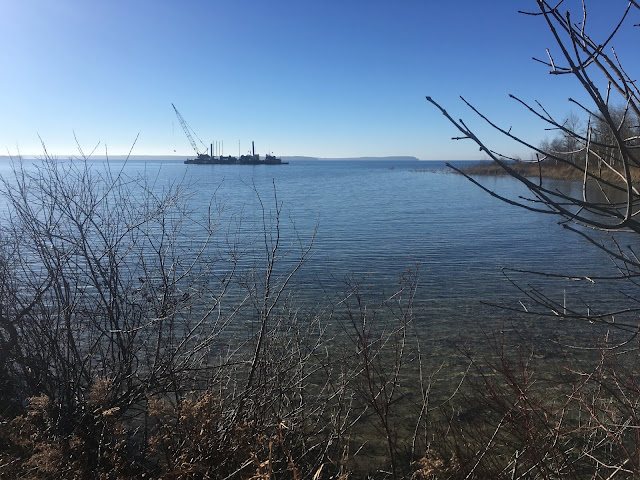A joke, of course, but Hoyt may have correctly put his finger on the future dependability of the Island's power source.
As of 1:00 p.m. Friday, Lee Engstrom reported, the Island's power shifted from the old submarine cable to the new cable, and without a hitch. Both men serve as directors of the REA Board, and they, as well as Manager Robert Cornell and other REA crew and Directors, should feel both relieved and proud of this accomplishment. Lee accompanied contractors daily during cable repair and cable laying activities in order to properly document with photos this past year's events.
Problems began with the unanticipated underwater cable failure in June, and the need to repair that break as quickly as possible. This initiated multiple steps in logistics and timing: underwater divers; a cable splicing crew; a work barge with tug to lift and cut the failed section and then reset the repaired cable back in place.
 |
| In the fall of 1980, cable arrived on a barge, but so had winter, and it would be spring before weather permitted laying the first underwater electric cable for the Island. |
The checklist was long, the cost was unexpected, and the long-term outlook, given the old cable's status, remained one of uncertainty.
That cable had been laid in spring of 1981, but given the low draw compared to its rated capacity, and given exclusive use in fresh water, expectations were for it to have a longer life span. However, along the relatively flat rock bottom west of Plum Island, and at a depth of 40 feet, ice nevertheless had shoved and abraded the cable over time. Fortunately, this break resulting in an instant power outage on the Island occurred at the start of our summer and in warmer weather. This made cable location and repair easier than if it had been mid-winter. Generators were then started and placed on line, but at a significant cost in daily fuel consumption. An emergency CAT generator had to be located and trucked to the Island when one of the two REA units suffered failure of an air intake casting. This series of events even further compounded the main cable repair challenge and stretched limited resources of the Co-op team.
Almost as soon as cable failure occurred and simultaneous with the on-going repairs that would stretch to ten days' time, the REA's plan of action was exercised, led by the Electric Co-op's manager, Robert Cornell. It called for the procurement of a new cable, to be manufactured by an east coast firm. It would be of length based on a new route, different from that previously used. Rather than route the cable around Plum Island as was previously done, a route that might once again subject the cable to shoving ice fields, this time the cable would be laid inside a polyethylene sleeve and trenched to at least 20-foot depth, and it would run from Northport to Plum Island. Then the cable would cross Plum Island underground, using less expensive, land-based cable material trenched in soil. Near the old Plum Island Life Saving Station it would reenter the lake and from there cross to Washington Island. It would come ashore alongside the 1981 electric cable, in an easement adjacent to the former Goodwin Berquist property. Now, a new switch box links both old and new underwater cables to terminals that can connect to the underground cable leading inland to the REA distribution center, on Main Road.
 |
| Island lineman Mike Jorgenson with Public Service splicing crew, Feb. 4. New switch box shown. Ferry Arni J. Richter is a dot near the horizon, background. |
Like any large project, timing is everything: to obtain needed cable from manufacturer before freeze up, when ice covers the lake and makes waterborne construction impossible; trenches dug from shore into the water at four locations, with a ten-inch polyethylene sleeve buried and ready to accept the cable at each entry point; and also, to lay the Plum Island segment of underground cable while landing there with men and equipment was still easily managed.
The new cable arrived by truck in Sturgeon Bay, later than expected and promised, on enormous reels. It was loaded on contractor Roen's work barge at Bay Shipbuilding. This delay in cable delivery pushed back laying new cable until the middle of December. But then, by good fortune, a series of windless, warm days permitted the Roen crew to successfully lay the two segments of underwater cable. Only a few hundred feet of surplus remained on either side of the runs, in the event of course deviation while tug and barge laid cable.
A separate company monitored the laying of the cable with underwater cameras to assure the new electric cable did not pass over large, sharp rocks, or suspend, unsupported, over wide crevices.
The splicing of cable segments to one another, and to the Wisconsin Public Service feed at Northport, was completed, then, this past week, with the new cable becoming "live" early Friday afternoon. The old cable remains energized, just in case, under a greatly reduced load, in order to remain dry and usable.
Sections of plastic conduit were bolted together into approx.
500-ft. lengths and laid out on the Potato Dock prior to being
towed into position and sunk into trenches dug at each exit/entry point.
Red conduit is for fiber-optic cable. (Taken in early December.)
 |
Congratulations on a major effort, a "well done" to all involved.
Now, what about the fiber optic cable laid alongside the new electrical cable? It's caused Co-op manager Robert Cornell the least concern, up until now. As this project winds up (some back-filling still necessary where the cable enters/exits near shore at Northport) it, too, will get attention.
- Dick Purinton

